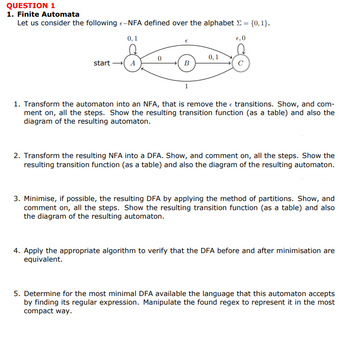0,1 start A B 1 € 1. Transform the automaton into an NFA, that is remove the transitions. Show, and com- ment on, all the steps. Show the resulting transition function (as a table) and also the diagram of the resulting automaton. 2. Transform the resulting NFA into a DFA. Show, and comment on, all the steps. Show the resulting transition function (as a table) and also the diagram of the resulting automaton.
0,1 start A B 1 € 1. Transform the automaton into an NFA, that is remove the transitions. Show, and com- ment on, all the steps. Show the resulting transition function (as a table) and also the diagram of the resulting automaton. 2. Transform the resulting NFA into a DFA. Show, and comment on, all the steps. Show the resulting transition function (as a table) and also the diagram of the resulting automaton.
Database System Concepts
7th Edition
ISBN:9780078022159
Author:Abraham Silberschatz Professor, Henry F. Korth, S. Sudarshan
Publisher:Abraham Silberschatz Professor, Henry F. Korth, S. Sudarshan
Chapter1: Introduction
Section: Chapter Questions
Problem 1PE
Related questions
Question

Transcribed Image Text:QUESTION 1
1. Finite Automata
Let us consider the following -NFA defined over the alphabet = {0,1}.
F-
0,1
€,0
0,1
start → A
B
1. Transform the automaton into an NFA, that is remove the transitions. Show, and com-
ment on, all the steps. Show the resulting transition function (as a table) and also the
diagram of the resulting automaton.
2. Transform the resulting NFA into a DFA. Show, and comment on, all the steps. Show the
resulting transition function (as a table) and also the diagram of the resulting automaton.
3. Minimise, if possible, the resulting DFA by applying the method of partitions. Show, and
comment on, all the steps. Show the resulting transition function (as a table) and also
the diagram of the resulting automaton.
4. Apply the appropriate algorithm to verify that the DFA before and after minimisation are
equivalent.
5. Determine for the most minimal DFA available the language that this automaton accepts
by finding its regular expression. Manipulate the found regex to represent it in the most
compact way.
Expert Solution
This question has been solved!
Explore an expertly crafted, step-by-step solution for a thorough understanding of key concepts.
Step by step
Solved in 2 steps with 2 images

Follow-up Questions
Read through expert solutions to related follow-up questions below.
Follow-up Question
can i get the answer to 3 please, than you very much!

Transcribed Image Text:QUESTION 1
1. Finite Automata
Let us consider the following -NFA defined over the alphabet = {0,1}.
F-
0,1
€,0
0,1
start → A
B
1. Transform the automaton into an NFA, that is remove the transitions. Show, and com-
ment on, all the steps. Show the resulting transition function (as a table) and also the
diagram of the resulting automaton.
2. Transform the resulting NFA into a DFA. Show, and comment on, all the steps. Show the
resulting transition function (as a table) and also the diagram of the resulting automaton.
3. Minimise, if possible, the resulting DFA by applying the method of partitions. Show, and
comment on, all the steps. Show the resulting transition function (as a table) and also
the diagram of the resulting automaton.
4. Apply the appropriate algorithm to verify that the DFA before and after minimisation are
equivalent.
5. Determine for the most minimal DFA available the language that this automaton accepts
by finding its regular expression. Manipulate the found regex to represent it in the most
compact way.
Solution
Knowledge Booster
Learn more about
Need a deep-dive on the concept behind this application? Look no further. Learn more about this topic, computer-science and related others by exploring similar questions and additional content below.Recommended textbooks for you

Database System Concepts
Computer Science
ISBN:
9780078022159
Author:
Abraham Silberschatz Professor, Henry F. Korth, S. Sudarshan
Publisher:
McGraw-Hill Education

Starting Out with Python (4th Edition)
Computer Science
ISBN:
9780134444321
Author:
Tony Gaddis
Publisher:
PEARSON

Digital Fundamentals (11th Edition)
Computer Science
ISBN:
9780132737968
Author:
Thomas L. Floyd
Publisher:
PEARSON

Database System Concepts
Computer Science
ISBN:
9780078022159
Author:
Abraham Silberschatz Professor, Henry F. Korth, S. Sudarshan
Publisher:
McGraw-Hill Education

Starting Out with Python (4th Edition)
Computer Science
ISBN:
9780134444321
Author:
Tony Gaddis
Publisher:
PEARSON

Digital Fundamentals (11th Edition)
Computer Science
ISBN:
9780132737968
Author:
Thomas L. Floyd
Publisher:
PEARSON

C How to Program (8th Edition)
Computer Science
ISBN:
9780133976892
Author:
Paul J. Deitel, Harvey Deitel
Publisher:
PEARSON

Database Systems: Design, Implementation, & Manag…
Computer Science
ISBN:
9781337627900
Author:
Carlos Coronel, Steven Morris
Publisher:
Cengage Learning

Programmable Logic Controllers
Computer Science
ISBN:
9780073373843
Author:
Frank D. Petruzella
Publisher:
McGraw-Hill Education